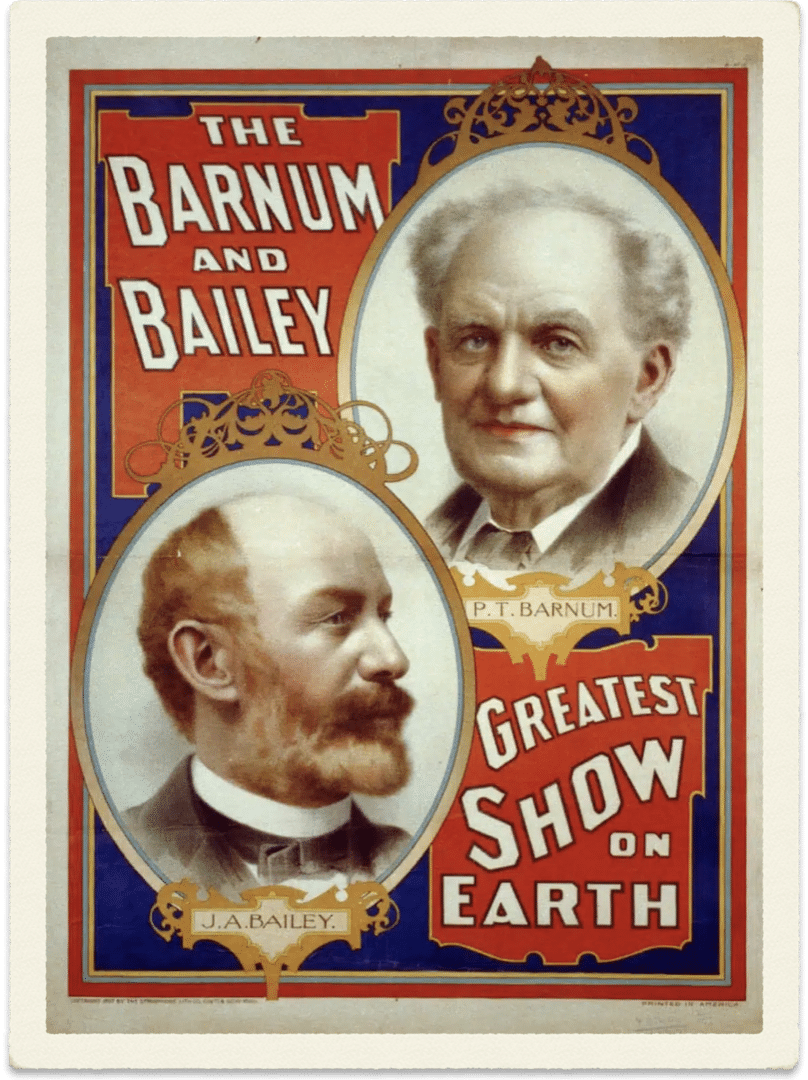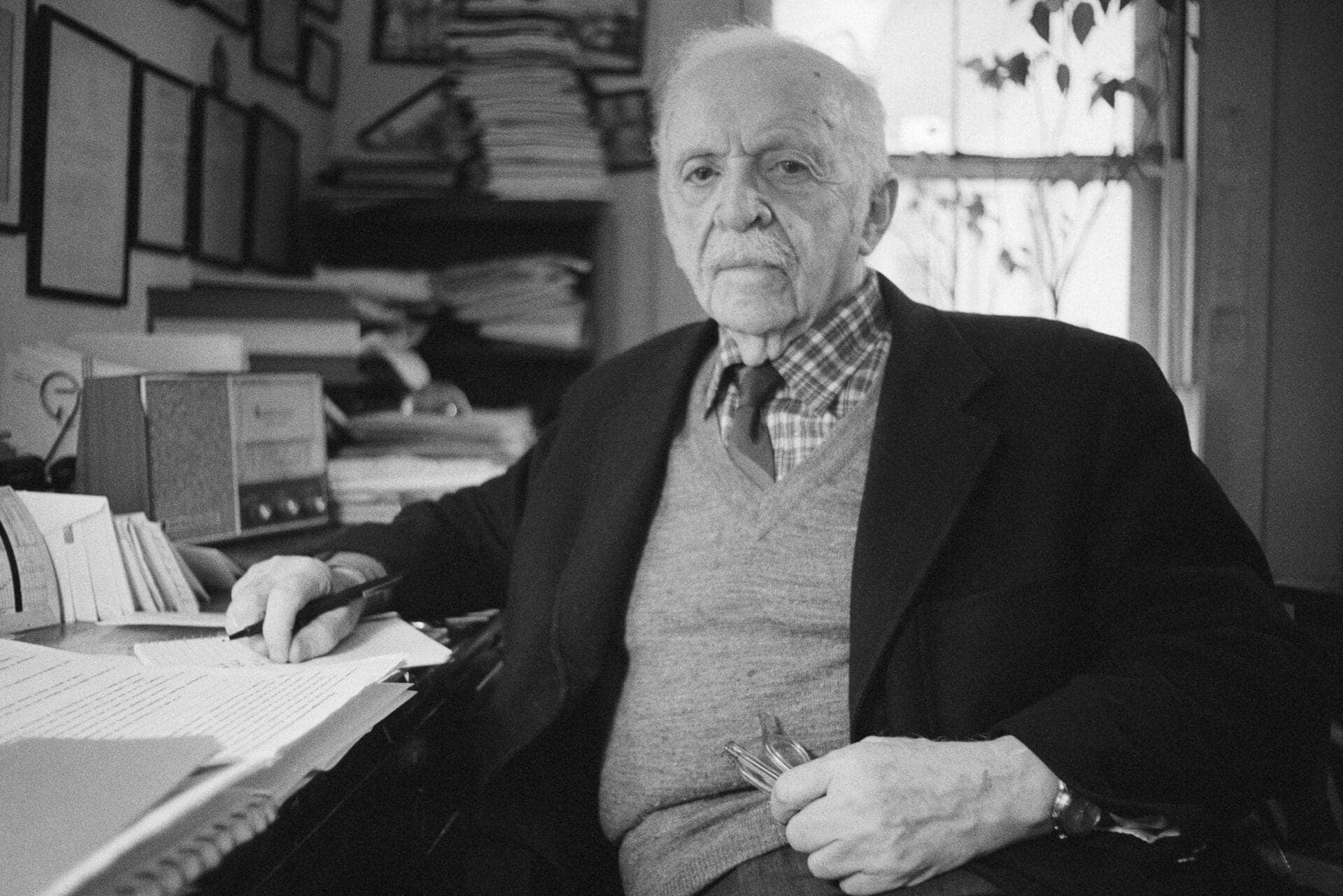“There’s no such thing as bad publicity.”
Or, how about: “No publicity is bad publicity.”
As PR professionals, we’ve all heard the expression many times before. But where does it come from? Those infamous words were allegedly uttered by P.T. Barnum, a legendary showman and circus director.
Although verifying that P.T. Barnum should be credited is difficult, it’s interesting to learn more about the controversial legend and better understand why the saying persists today.
Here we go:
“There’s No Such Thing as Bad Publicity”
Phineas Taylor Barnum: “There’s No Such Thing as Bad Publicity”
Phineas Taylor (P.T.) Barnum was a 19th-century American showman, entrepreneur, and politician known for his larger-than-life personality and uncanny ability to capture the public’s imagination. Born in 1810 in Bethel, Connecticut, Barnum rose to prominence in the entertainment world by founding the Barnum & Bailey Circus, dubbed “The Greatest Show on Earth.”

Barnum pioneered the art of the press agentry model, employing sensationalism and publicity stunts to generate interest and draw crowds to his shows. His innovative marketing techniques and relentless pursuit of the extraordinary laid the groundwork for many modern public relations strategies.
“Phineas Taylor (P.T.) Barnum (1810−1891) was a savvy publicity showman, one who impacted particular aspects of public relations and advertising, primarily event planning, event promotion and true publicity/media coverage. Ahead of others in his time, he actually understood the importance of media coverage (he started New York’s first illustrated newspaper in 1853) and believed ‘there is no such thing as bad publicity,’ a popular phrase many times attributed to Barnum himself.”
Source: Big Communications 1Foster, A. (2017, January 20). The End of a Publicity Era: How P.T Barnum Affected Marketing and PR. Big Communications. https://bigcom.com/2017/01/pt-barnum-marketing-and-public-relations/
Although some critics have labelled Barnum as a purveyor of hoaxes and deception, his enduring legacy as a visionary showman and master of spectacle continues to captivate audiences and inspire generations of entertainers and entrepreneurs.
An organisation, starved of attention, trust, and loyalty, is compelled to wage a perpetual struggle for its continued existence.
Learn more: P.T. Barnum: “There’s No Such Thing as Bad Publicity”
Is Bad Publicity Actually … Good?
Not all publicity is good publicity — of course.
But it’s complicated, too. Someone’s bad publicity is often good for someone else, and vice versa. Bad publicity for your competitor could mean less business for them and more for you.
There are also conversion theory effects. Suppose a controversial music artist gets bad publicity for provocative stage behaviours. In that case, it might result in angered parents, resulting in teenagers queueing for hours to see the show.
“Make parents angry!”
— Shep Gordon, talent manager and film agent 2Supermensch: The Legend of Shep Gordon. (2023, December 18). In Wikipedia. https://en.wikipedia.org/wiki/Supermensch:_The_Legend_of_Shep_Gordon
Then, there’s the amplification hypothesis:
The harder you attack someone verbally, the more you convince them of their belief, not yours.
This, of course, goes for publicity as well.
However, P.T. Barnum likely referred to another psychological aspect of bad publicity (which isn’t often discussed in public relations or elsewhere). Sometimes, from a business perspective, it’s better to be infamous than entirely unknown.
“People want to be loved; failing that admired; failing that feared; failing that hated and despised. They want to evoke some sort of sentiment. The soul shudders before oblivion and seeks connection at any price.”
— Hjalmar Söderberg (1869−1941), Swedish author
If a circus attracts bad publicity, plenty of people will still be curious to learn what all the fuss is about. If they’re going to dislike something, why not get some “scandalous” first-hand gossip themselves first? For the circus, it beats being unknown and getting zero tickets sold.
Learnings from the “Prince of Humbugs”
P.T. Barnum, often hailed as the “Prince of Humbugs,” played a critical role in developing the modern circus. However, his life and career extended beyond the circus tent and provided numerous lessons pertinent to the business landscape.
The following are some of the most significant learnings from Barnum, viewed through the lens of contemporary management and leadership practices:
Though drawn from a markedly different era and industry, these learnings from P.T. Barnum remain surprisingly applicable to modern businesses.
No such thing as bad publicity? Well, it’s complicated. But as for generating “bad publicity” on purpose, I’d suggest leaving any such advanced (and highly volatile!) PR strategies to professionals.

THANKS FOR READING.
Need PR help? Hire me here.

PR Resource: Notable PR Contributors
Spin Academy | Online PR Courses

Influencing PR: Notable Contributors
It’s noted that the gender bias is apparent here. I’m currently researching a more balanced list.
Public Relations Contributors
Learn more: All Free PR Courses
💡 Subscribe and get a free ebook on how to get better PR.

PR Resource: The Amplification Hypothesis
The Amplification Hypothesis
It’s common to find that counterarguments strengthen existing beliefs instead of weakening them.
The harder you attack someone verbally, the more you convince them of their belief, not yours.
The phenomenon is known as the amplification hypothesis, where displaying certainty about an attitude when talking with another person increases and hardens that attitude.
“Across experiments, it is demonstrated that increasing attitude certainty strengthens attitudes (e.g., increases their resistance to persuasion) when attitudes are univalent but weakens attitudes (e.g., decreases their resistance to persuasion) when attitudes are ambivalent. These results are consistent with the amplification hypothesis.“
Source: Journal of Personality and Social Psychology 3Clarkson, J. J., Tormala, Z. L., & Rucker, D. D. (2008). A new look at the consequences of attitude certainty: The amplification hypothesis. Journal of Personality and Social Psychology, … Continue reading
How does the amplification hypothesis work?
In a threatening situation or emergency, we resort to the primal (fastest) part of the brain and survival instincts (fight, flight and freeze). 4Surviving the Storm: Understanding the Nature of Attacks held at Animal Care Expo, 2011 in Orlando, FL.
Establishing common ground and exhibiting empathy demonstrates a genuine understanding of their perspective, fostering trust and openness to your ideas. Conversely, a strategic mismatch of attitudes can serve as a powerful countermeasure if your objective is to deflect persuasive attempts.
Persuade
To persuade, align your attitude with the target. Otherwise, you will only act to create resistance.
Provoke
To put off a persuader, mismatch their attitudes. When they are logical, be emotional, and vice versa.
Learn more: The Amplification Hypothesis: How To Counter Extreme Positions
PR Resource: The Anatomy of Attention
The Anatomy of Attention
Attention is an essential component of public relations:
An organisation, starved of attention, trust, and loyalty, is compelled to wage a perpetual struggle for its continued existence.
And it’s not just organisations. We all seem to crave attention in some form or another:
“People want to be loved; failing that admired; failing that feared; failing that hated and despised. They want to evoke some sort of sentiment. The soul shudders before oblivion and seeks connection at any price.”
— Hjalmar Söderberg (1869−1941), Swedish author
It’s fear of social isolation—and attention starvation.
“There’s only one thing in the world worse than being talked about, and that is not being talked about.”
— Oscar Wilde
Types of Attention
But what constitutes ‘attention’?
“Attention is a complex, real neural architecture (‘RNA’) model that integrates various cognitive models and brain centers to perform tasks like visual search.”
Source: Trends in cognitive sciences 8Shipp, S. (2004). The brain circuitry of attention. Trends in Cognitive Sciences, 8, 223 – 230. https://doi.org/10.1016/j.tics.2004.03.004
Each of the below terms refers to a specific aspect or type of attention (“mental bandwidth”), a complex cognitive process. 9Schweizer, K., Moosbrugger, H., & Goldhammer, F. (2005). The structure of the relationship between attention and intelligence. Intelligence, 33(6), 589 – 611. … Continue reading
Let’s explore different types of attention:
Each type of attention is likely to play a role in how we interact with and process information from our environment, and understanding these different aspects is key in fields like psychology, neuroscience, and education.
Learn more: The Anatomy of Attention
PR Resource: A Glass of Many Truths

Spin Academy | Online PR Courses
A Glass of Many Truths
Let’s say that there’s a glass of water standing on a table in front of you — and there’s water in it. The glass holds 100 ml of water but could store 200 ml if filled up.
I could say that the glass is half full. That’s true.
I could also say that the glass is half empty. Still true.
Both statements are equally valid, of course, but the choice of words will influence our stereotypical thinking about the state of the glass and its content.
The second statement emphasises emptiness (the glass needs a refill), and the first statement is fullness (the glass needs no refill).
Now, let’s get even more creative:
The glass is full. True, yes?
Technically, this statement is true as well:
50% of the glass contains water; the other 50% is split between roughly 78% nitrogen, 21% oxygen, argon, carbon dioxide, and small amounts of other gasses.
How about this:
The glass is not half full, nor is it half empty. Also true.
An equal split between water and gasses implies an exact division of protons, neutrons, and electrons. But Heisenberg’s uncertainty principle says no.
Such accuracy might not matter to you or me, but for a physicist, these precise versions of the truth might make all the difference.
So, what does a glass of water have to do with PR?
Learn more: Does Spin Suck?
💡 Subscribe and get a free ebook on how to get better PR.

Annotations
| 1 | Foster, A. (2017, January 20). The End of a Publicity Era: How P.T Barnum Affected Marketing and PR. Big Communications. https://bigcom.com/2017/01/pt-barnum-marketing-and-public-relations/ |
|---|---|
| 2 | Supermensch: The Legend of Shep Gordon. (2023, December 18). In Wikipedia. https://en.wikipedia.org/wiki/Supermensch:_The_Legend_of_Shep_Gordon |
| 3 | Clarkson, J. J., Tormala, Z. L., & Rucker, D. D. (2008). A new look at the consequences of attitude certainty: The amplification hypothesis. Journal of Personality and Social Psychology, 95(4), 810 – 825. https://doi.org/10.1037/a0013192 |
| 4 | Surviving the Storm: Understanding the Nature of Attacks held at Animal Care Expo, 2011 in Orlando, FL. |
| 5 | Silfwer, J. (2017, June 13). Conversion Theory — Disproportionate Minority Influence. Doctor Spin | The PR Blog. https://doctorspin.net/conversion-theory/ |
| 6 | Beck (1999): Homogenization, Dehumanization and Demonization. |
| 7 | Cognitive dissonance. (2023, November 20). In Wikipedia. https://en.wikipedia.org/wiki/Cognitive_dissonance |
| 8 | Shipp, S. (2004). The brain circuitry of attention. Trends in Cognitive Sciences, 8, 223 – 230. https://doi.org/10.1016/j.tics.2004.03.004 |
| 9 | Schweizer, K., Moosbrugger, H., & Goldhammer, F. (2005). The structure of the relationship between attention and intelligence. Intelligence, 33(6), 589 – 611. https://doi.org/10.1016/j.intell.2005.07.001 |


